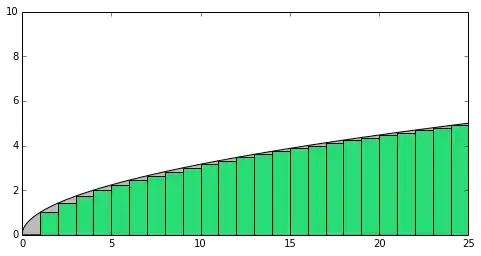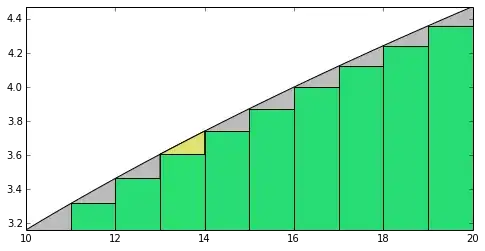How do I estimate the error for the sum of reciprocals of square roots. From calculus we know that:
$$ \int_0^n \sqrt{x} \, dx = \frac{2}{3} x\sqrt{x} \;\;\Bigg|_{x=0}^{x=n} = \frac{2}{3}n\sqrt{n}$$
I forget the name - midpoint rule, trapezoid rule ?? - basically we want to approximate the integral as a Riemann sum. How do we estimate the error?
$$ \left(1 + \sqrt{2} + \sqrt{3} + \dots + \sqrt{n} \right) - \frac{2}{3} n \sqrt{n}$$
To give you a sense of how much we are losing on this approximation, let's draw two pictures.
We are losing all the gray stuff in our approximation, which is quite a lot! I don't really care about the integral, what's important is the difference between all the stuff we are adding and square root of $n$.
The yellow triangle has base $1$ and height $\sqrt{14} - \sqrt{13}$ so the area is:
$$ A = \frac{1}{2} \times b \times h = \frac{1}{2} \times 1 \times (\sqrt{\color{#E0E070}{14}} - \sqrt{\color{#E0E070}{13}}) = \frac{1}{2}(\sqrt{n+1} - \sqrt{n}) \approx \frac{1}{4 \sqrt{n}}$$
This suggests the total of all errors is about $\propto \sqrt{\color{#D22}{n}}$ which is not a small amount. Can anyone get the constant of proportionality?
The Euler-Maclaurin machine does crank out such error estimates, but the square root function is not so strange. Can we derive such an estimate in this specific case using basic standard inequalities?

